

3D printing makes it possible to manufacture and prototype a wide range of applications quickly. Choosing the right 3D printing technique is one aspect of the process and selecting the right 3D printing material for the technique is another crucial aspect.
There is an array of materials that can be processed via 3D printing and additive manufacturing techniques, and each material has its unique set of properties. Choosing the right 3D printing material is crucial, as it directly impacts the aesthetic and functional characteristics of your printed parts. You should note that each 3D printing material has a unique set of properties that are similar to and distinct from others.
Understanding the various material options in 3D printing techniques enables manufacturers to make an informed decision by considering all aspects. It helps manufacturers to ensure that the aesthetic and functional requirements are not only met but cost-efficient choices are also considered thereby, optimizing the operational processes. It also helps manufacturers to acknowledge material compatibility with specific 3D printers thus, streamlining the printing process and minimizing damage.
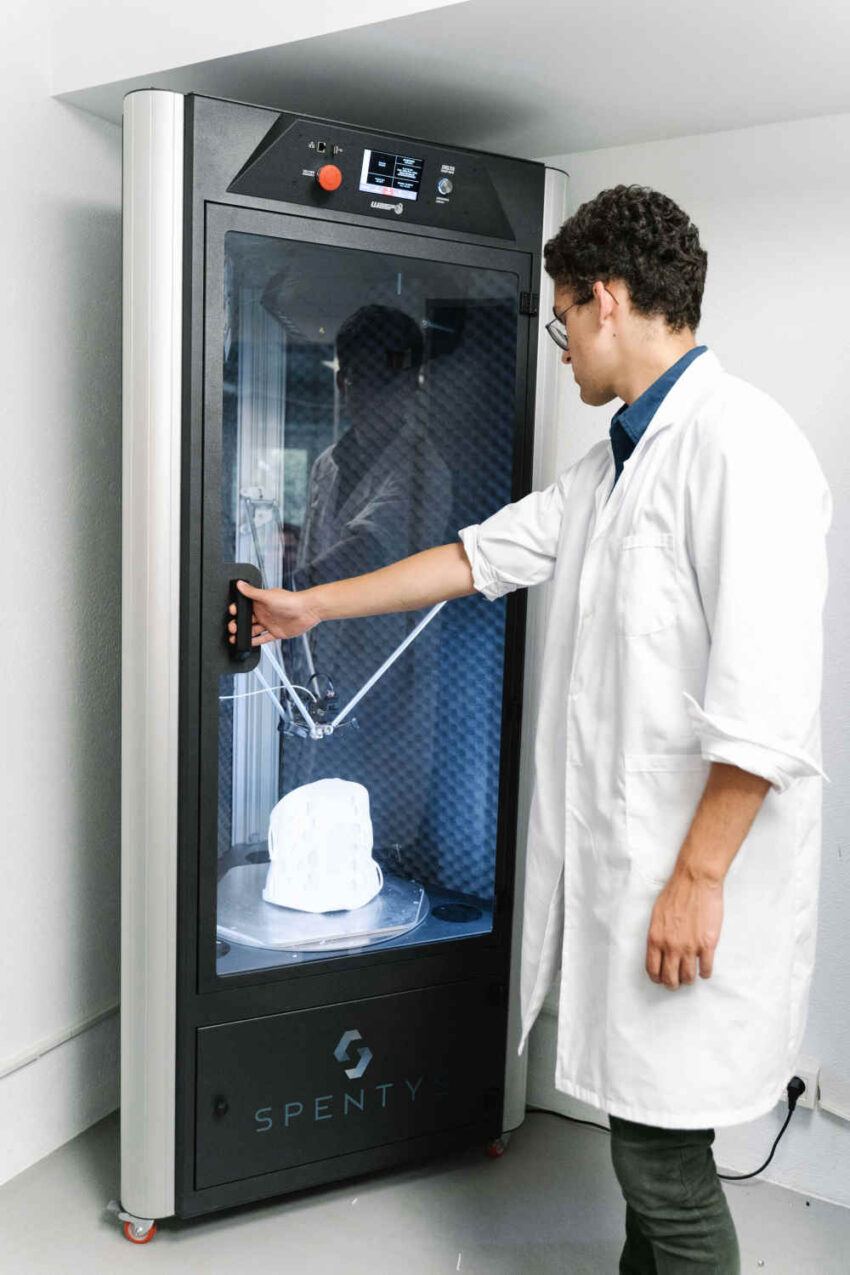
In this article, we discuss the most common materials that are employed for 3D printing techniques. This is a comprehensive guide that discusses 3D printing materials, their properties, and how you can choose the right 3d printing material for your application.
ABS is one of the most widely employed 3D printing materials and its parts demonstrate outstanding durability, excellent strength-to-weight ratio, resistance to high temperatures, and affordability. It is especially applied in rapid prototyping and it facilitates post-processing techniques.
You should note that ABS emits harmful volatile organic compounds during the 3D printing process. It is thus advisable to exercise prudent caution by printing ABS in ventilated spaces. You can read more about ABS here.
ASA is an excellent alternative to ABS that’s easier to print! It demonstrates improved impact strength, chemical resistance, thermal resistance, and mechanical properties. In addition, ASA is UV stable as it retains color upon sunlight and UV exposure thus, it’s an ideal material if the use is for outdoors.
ASA also exhibits reduced warping tendencies when compared to ABS, thus, simplifying the 3d printing process to a large extent. ASA can be easily printed via industrial FDMs.
Polypropylene is a semi-crystalline plastic that’s versatile. It demonstrates excellent fatigue and chemical resistance. You should note that it does tend to warp during the printing process. You can read more about PP here.
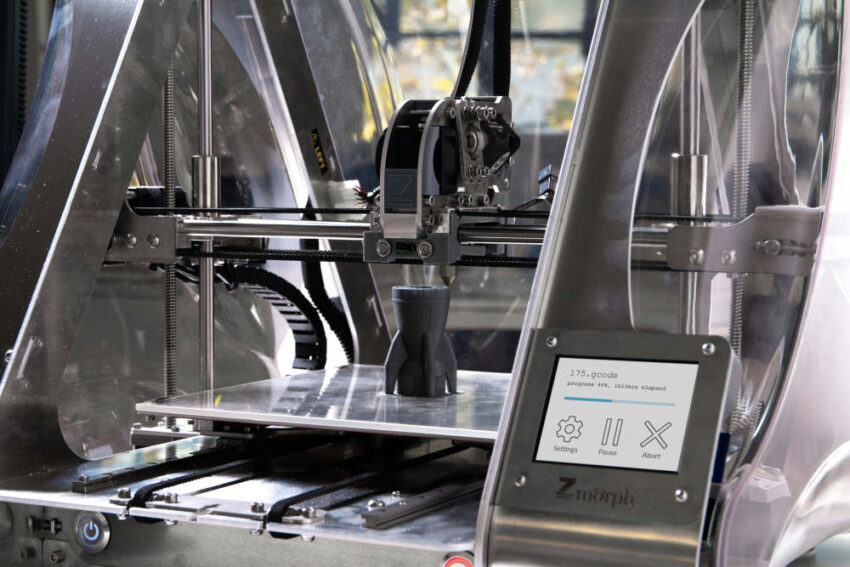
PLA is a popular 3D printing material that’s derived from eco-friendly and renewable resources. It’s recyclable at industrial facilities and is not biodegradable.
PLA is easy to use! It’s affordable and compatible with FDM 3D printers. It has a relatively low printing temperature i.e. 190–215°C / 374–419°F and minimal tendencies towards warping. You should note that PLA is not as durable as ABS and is sensitive to high temperatures.
It’s ideal for creating prototypes and is available in an array of varieties.
Polyamide, commonly referred to as nylon, is a robust 3D printing material that’s very versatile and is employed for an array of applications. It can be reinforced with various fibers such as Kevlar, carbon, and glass to incorporate distinct physical, chemical, and mechanical properties.
Nylon is extremely durable and demonstrates exceptional toughness, great tensile strength, and resistance towards impact and high temperatures. However; it’s not easy to print with Nylon.
To 3D print Nylon, a high-temperature nozzle that is capable of reaching up to 300°C / 572°F should be incorporated. In addition, correct storage is required since Nylon readily absorbs moisture upon exposure to air which can lead to material degradation. You can read more about Nylon here.
PC is a strong 3D printing material. It demonstrates excellent toughness and resistance to heat while being durable and flexible. It also has excellent optical clarity and is extensively employed for printing clear and translucent components.
Just like Nylon, PC also absorbs moisture from its environment which leads to warping or layer separation during printing. Thus, it is crucial to correctly store the PC. You can read more about PC here.
HIPS is a blend of polystyrene plastic and polybutadiene rubber that is primarily used in 3D printing as a support material.
Since it’s a blend of polymers, it demonstrates excellent toughness, resistance to high-impact forces, and flexibility. It is compatible with a wide range of adhesives and is versatile. It also holds an FDA-compliant status for various food processing applications.
It dissolves in a limonene solution, thereby eliminating the need for removal via abrasives or cutting tools. You should note that this cannot be utilized with every material as it can damage the material.
PEI, abbreviated for Polyetherimide, is a high-performance plastic and its branded name is Ultem®.
PEI has an exceptional strength-to-weight ratio which makes it an effective alternative to metal. Due to this quality, PEI can be employed instead of steel in certain applications. It’s also lightweight and strong, such that it can be used to replace Aluminium in other applications.
PEI demonstrates excellent mechanical, thermal, and electrical properties. It’s flame-resistant, UV-light resistant, and displays exceptional hydrolytic stability.
Polyetheretherketone is not the most efficient polymer that can be 3D printed as its industrial use is limited to very specific printers. However; its unique properties have made it popular for applications in certain industries such as the military and petrochemicals.
PEEK is an excellent replacement for metal parts as it weighs half of Aluminium and 1/6th of Steel. It’s also highly resistant to corrosive fluids, extreme temperatures, and high-pressure steam. It demonstrates excellent creep resistance and dimensional stability.
Polyvinylidene Fluoride is widely applied in 3D printing for its unique properties. It demonstrates excellent thermal properties and exhibits very low warping. PVDF also exhibits great resistance to abrasion and most chemicals. In addition, it can withstand some of the most extreme conditions such as nuclear radiation.
Metal is the second most popular material that is specifically employed for metal 3D-printing techniques. Let’s understand these techniques further:
Steel can be employed for most 3D printing techniques. Let’s understand the various types of steels employed in metal 3D printing:
Titanium is the next metal that is employed in various industries such as aerospace, surgical tools, and electronics to manufacture parts via 3D printing.
Titanium and titanium-based alloys demonstrate excellent mechanical characteristics. It’s lightweight, strong, and resistant to heat, and oxidation. It also has a high strength-to-weight ratio and better corrosion resistance than stainless steel.
Aluminum and Aluminum-alloys are economical and easy to 3D print. It’s lightweight and is yet strong and durable.
Aluminum demonstrates excellent thermal properties and chemical resistance.
The wood 3D filament is employed for specific aesthetic purposes. You should note that, when compared to other materials, it isn’t as flexible or comparable in terms of strength.
In addition, wood 3D printing material accelerates the wear and tear of the printer’s nozzle.
Wood 3D printing material is a composite that typically consists of PLA infused with wood fibers. There is an array of options for Wood PLA 3D printers and they range from options such as pine, cedar, birch, bamboo, and coconut to more.
Thermoplastic elastomers combine plastic and rubber to create a unique set of properties. You can read more about TPEs here. TPEs are versatile but 3D printing TPEs require precise control over the printing process.
TPEs are soft and flexible. They are particularly employed for manufacturing stretchable parts that can be bent without being deformed or losing their shape.
An e.g. of TPE is TPU, abbreviated for Thermoplastic polyurethane. TPUs demonstrate exceptional durability and are highly resistant to abrasion, chemicals, and extreme temperatures. Another e.g. of TPE is TPC, abbreviated for Thermoplastic co-polyester. TPCs demonstrate excellent resistance to UV and high temperatures.
Graphite and Graphene are popular in 3D printing techniques due to their exceptional strength, flexibility, light-weightedness, and outstanding electrical conductivity.
Graphene is composed of conductive carbon particulates, which can be added to base materials such as ABS or PLA and thus, can aid in electricity conduction. The following infographic enlists the difference between Graphite and Graphene:
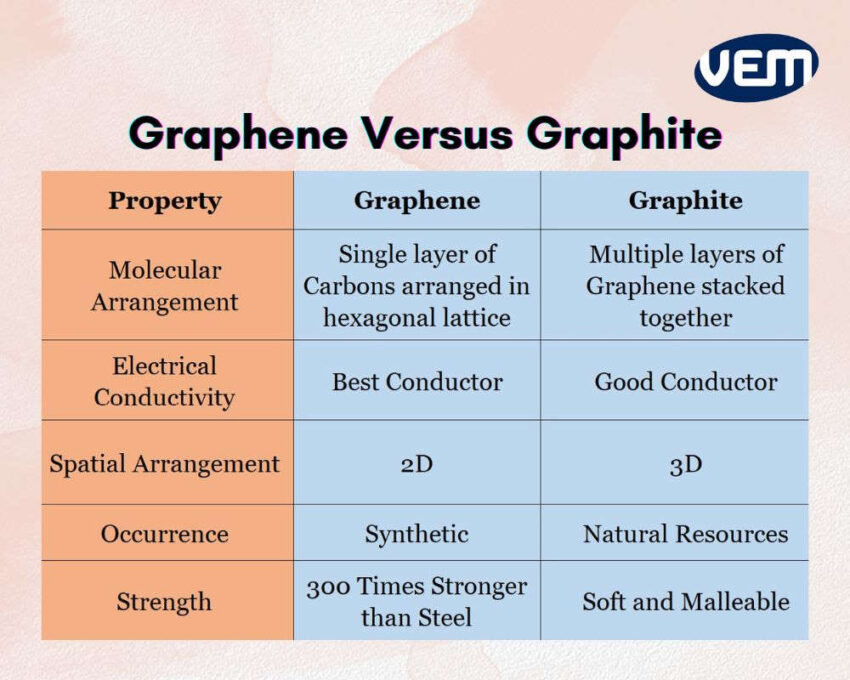
The 3D printing process includes various types of processes and only certain material types are suited for a particular 3D printing process. In this section, we briefly explain the popular 3D printing processes and their compatible materials.
FDM, abbreviated for Fused Deposition Modeling is also known as Fused Filament Fabrication technique. It is one of the most widely incorporated 3D printing techniques at the industrial and consumer level but you should note that when compared to the other 3D printing processes, FDM has the lowest resolution and accuracy. It is also not the best fit for printing complex designs. Industrial FDM 3D printers can mitigate some of these drawbacks issues but they are steeply priced.
FDM is best suited for developing simple proof-of-concept models. It can also be employed for low-cost prototyping of simple parts.
Although the most popular 3D Printing materials for FDM printing are ABS and PLA, various other materials can be processed via FDM.
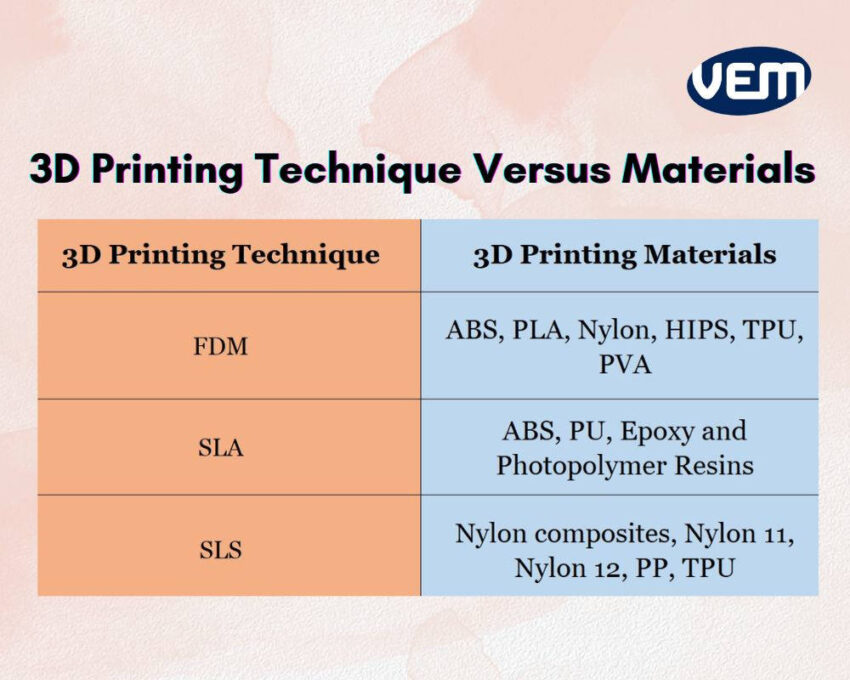
SLA is the most popularly employed 3D printing technology! SLA 3D printed parts demonstrate the highest level of accuracy and resolution compared to the rest of the 3D printing technologies. They also deliver an excellent smooth surface finish!
SLA 3D Printing is apt for developing highly detailed prototypes that require tight tolerances. They are also employed for creating functional parts, such as molds and end-use parts.
SLA 3D printing demonstrates exceptional versatility and works well with a variety of formulations.
SLS 3D printing technique develops strong and functional parts. It demonstrates high productivity and low cost per part. This technique is employed and is ideal for an array of applications such as rapid prototyping, low volume, and custom manufacturing.
In the case of the SLS 3D printing technique, the unfused powder supports the part thus, eliminating the requirement of dedicated support structures. SLS 3D printing is thus ideal for creating complex geometry designs that may include undercuts or thin walls.
SLS material selection is limited when compared to FDM and SLA. The most common materials employed are Nylon, TPU, and Polypropylene (PP).
Metal 3D printing is widely employed to create and manufacture metal parts and components. It’s suitable for printing strong and complex metal components.
The following materials are most commonly employed for metal 3D printing:
Let’s understand the metal 3D printing processes:
Multi Jet Fusion (MJF) technology is a powder-based 3D printing process. It can quickly deliver high-quality parts that are of high resolution and accuracy.
This technique works by depositing fusing and detailing agents in a powder bed which is then fused layer by layer. MJF 3D printer continues to distribute more powder on top of the bed, and this particular process repeats layer by layer.
Multi Jet Fusion is primarily compatible with Nylon but it also works well with Polypropylene and TPU.
PolyJet 3D Printer utilizes an inkjet-style process and creates highly precise and intricately detailed 3D prints. In this technique, tiny droplets of photopolymer resin are jetted to build a platform layer by layer. This is solidified by UV light curing.
Various materials are compatible with Polyjet 3D printers and they range from ABS and Polypropylene to Rubber-like and High-temperature materials.
Since there are an array of 3D printing materials to choose from, selecting the correct 3D material for your project can be challenging. In this section, we enlist
various aspects that can help you choose the right 3D Printing material for your application:
The first concept is to understand and correctly define the performance requirements of 3D printed parts. You should note that 3D Printing materials have distinct mechanical, physical, and chemical properties. These material properties impact the performance of 3D-printed parts. It is thus critical to understand the performance requirements. Let’s understand the three types of 3D printed parts performance requirements:
The next step is to understand the material requirements to achieve the expected performance requirements of the 3D printed part. Let’s understand some key material characteristics:
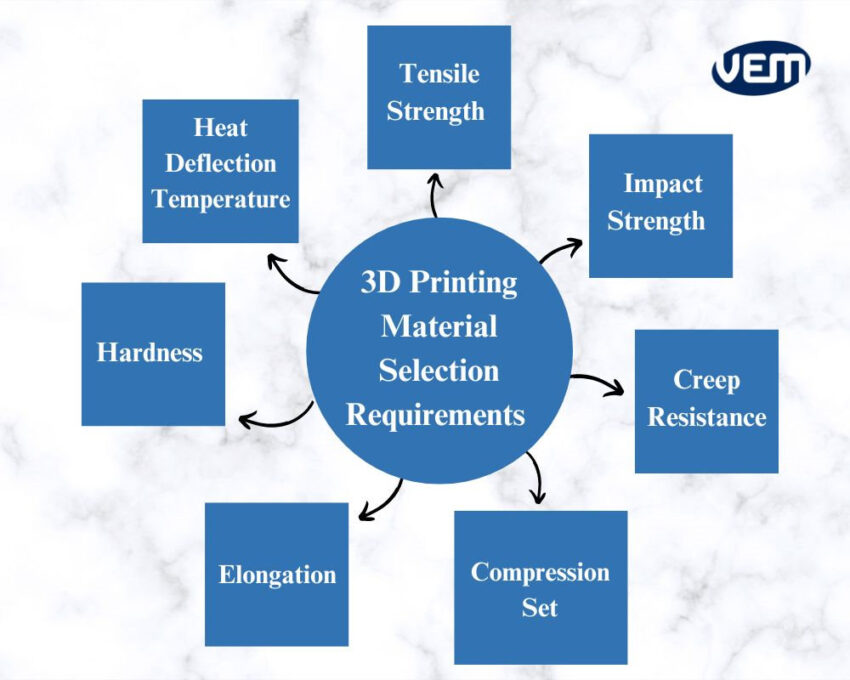
This characteristic indicates the material’s resistance to break under tension. If the tensile strength is high, it impacts the structural and mechanical strength of the part.
Elongation is the material’s resistance to breaking upon being stretched. It also indicates the material’s ability to suddenly break or deform.
Impact strength is the material’s ability to withstand shock without breaking. It indicates the toughness and durability of the material.
This characteristic indicates that a material can return to its original shape after being compressed. If the material can withstand permanent deformation, it indicates a good compression set.
Creep resistance is the material’s tendency to deform permanently due to stress. If the creep resistance is high, it indicates that the plastics have higher longevity.
This factor indicates if a particular material can endure high-temperature applications. It indicates the specific temperature at which a material starts to deform.
This characteristic is a measurement of the material’s resistance to surface deformation. It is a measurement of how easily a material can be dented or scratched.
To select the correct 3D printing material for your project, it is crucial to understand the various materials and their properties thoroughly. If you have any questions or concerns in selecting the best material for your project or improving the quality of your prints, you can contact us and we will get back to you right away.
Our team has extensive experience and they can guide you in selecting the most apt 3D printing material for your project.
You can read more about 3D printing here.